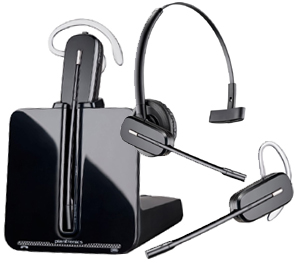The Difference between 900 mhz and 2.4 Ghz
Understanding the Differences Between 900MHz and 2.4GHz Wireless Headset Systems
You would always like to make the correct business decision be it financing, investment or communications products, it not about "feed & speeds," but actually products that help the company do tasking effectively and efficiently.
While thinking on which system of Wireless headset to buy the whole issue shouldn't boil down to 2.4GHz headsets or 900MHz headsets just because of the frequency, as none of the two are superior or inferior. Both headsets are different so are their respective frequencies, and the all-round wireless product quality isn't frequency dependent.
This decision has to come about based on the sole requirements that a company is looking to fulfill by purchasing the Wireless headset. For one to be able to make an educated choice depends upon getting to know the significance of features like security, comfort, talk time, range, audio quality, and their related advantages.
Frequency
Upon speaking on the matter of 900MHz devices & 2.4GHz devices, the context is related to the signal transmitted by device-it is modulation & frequency that form a signal.
Frequency stands for repeated cycles, per second during which a wave travels. Superior frequencies have greater number of such cycles per second and can influence user density, talk time and range.
One procedure of transmission of is modulation, or adding some data to the signal being carried, while it is frequency independent.
Let read some of 900MHz & 2.4GHz basic points:
With products that are wireless, the antenna's length is conversely proportional as against the frequency; lower frequency converts into the antenna being longer, higher frequency converts into the antenna being short. Normally, longer antenna converts into greater energy device efficiency.
Wireless devices with low frequency could give superior coverage & give improved obstacle incursion as supposed to devices with high frequency.
Wireless devices with low frequency could give superior talk times & need inferior power as compared to devices with high frequency.
While other things remaining identical, 2.4GHz devices function in higher band of frequency plus they give additional channels & far better probable density as compared to devices with lower frequency.
The devices that operate on 2.4GHz band frequency happen to recognized across the globe that is now being adopted as way of doing business. Prime illustrations of wireless technologies being applied in such frequency are 802.11b (WiFi) & Bluetooth.
Density
one more vital area to think on is aid with making the correct system for Wireless headset choice is density available to the user. Density available to the user means the number of wireless units that could be used in a single area prior to intrusion taking place between such units. This is of vital importance in places where greater numbers of workers use such wireless units being closed placed to one another.
The popularity of devices with high frequency is growing in big, enterprise-level businesses-such popularity could lead to making such solutions based on Wireless headsets having identical frequency a burden. For instance, 802.11b (WiFi) happens to be common for wireless Ethernet & is there in a rising no. of PDAs and laptops. Bluetooth is ideal where small data is to be exchanged in close vicinity, is radio solution that's low-cost which offers wire free connection between PDAs, computers, headsets, mobile phones, and other devices. 802.11b & Bluetooth both these devices function upon the frequency of 2.4GHz. With the increase of such devices being used in work place, wireless headsets of 900MHz can have lesser probable intrusion3 with the other production supporting 2.4GHz Wireless headsets.
Briefly:
Those devices based on a mixture of frequencies could be less prone to intrusion and those that are high quantity devices based on a single frequency could face greater interference.
Environment too affects density, with situation being unique at all times. A building's design and employee allocation in a particular region is a vital influential aspect.
Plantronics - What It Provides
Frequency isn't a telling issue nor for user advantage. It is a technology, as simple as that, which when applied with other technologies brings about company based solutions. For instance, features aren't frequency dependent for like verification or simple audio quality. Neither is productivity, standby time or talk time affected. Things like durability, reliability & comfort too aren't frequency dependent. These are just customer centric requirements, but frequency in its position of being a technology has no role to play in the shaping of such features.
At the end of all what the bottom line is that it should aid companies towards implementing the purpose of the choice of technology and more so the right one. For most offices an ideal hands-free wireless communication device would entail 4 basic needs:
All things said do think of the new Wireless Headset System for the office workplace from plantronics called Plantronics CS55. while speaking of all-round wireless headsets solution quality, you should know that a fine wireless headset device for the office is based upon various things like software design, electrical design, system engineering, human factors and acoustic design,. The CS 55 runs on a 1.9 ghz frequency
Besides launching the 1st featherweight headset for communications in the year 1962, Plantronics is presently the foremost designer and marketer & manufacturer of featherweight communications headset products across the globe. Its latest CS55 Headset System for office purpose is the newest entrant to this heritage.

 Follow us
Follow us
 Phone Finder
Phone Finder  Take A Look!
Take A Look! Check These Out!
Check These Out!
 Shopping Cart
Shopping Cart
 Bestsellers
Bestsellers





